|
Walsall Arboretum is one of the finest
public parks in the Black Country. It has many attractive
features including two large lakes, a variety of landscapes,
sporting facilities, and children’s play areas. The area
chosen for the arboretum has been a recreation area since
the mid 1830s when the limestone mines closed.
Early History
The land on which the Arboretum was
built belonged to the Reynolds family, and once formed part
of the extensive grounds of Reynolds Hall. In the 15th
century William Reynolds had a large estate in Walsall on
which the family’s home was built. In 1488, after his death,
his grand daughter Elizabeth Pearte of Darlaston inherited
the estate. She had a son, Richard Walker, by her second
husband, William Walker also of Darlaston. By 1528 she had
died, and Richard inherited the estate, which was later
passed-on to his daughter Elizabeth, who married John
Persehouse. By 1575 the house had become known as Reynolds
Hall, and would remain in the hands of the Persehouse family
for several generations.
Reynolds Hall had a typical medieval
layout with a hall, a parlour, a kitchen, and several
outbuildings, which were improved and extended by the
Persehouse family. During the Civil War the Persehouses were
Royalists, and so when the war ended, their estate was taken
from them. In the early 1660s after Charles II became King,
John Persehouse regained the estate, which passed-on from
one generation to another until the last Persehouse,
Richard, left the estate to his godson, John Walhouse.
In 1588 and 1589 a three storey,
jettied and timber framed building was added to the hall. It
had a porch at either end and included a kitchen, a larder,
two upstairs rooms with dormer windows, and a cock loft with
three 'clerestories'. The buildings contained at least 30
rooms and was listed in the hearth tax returns as having
nine hearths.
The hall stood on the slope to the
north of the Arboretum and was approached from the lower end
of Rushall Street by a long drive with an avenue of trees.
It was surrounded by large gardens, lined with ancient fruit
trees, and massive garden walls. The house remained occupied
until the late 18th century when John Walhouse decided to
demolish the hall, and destroy the gardens in order to
exploit the limestone beneath.
|
|
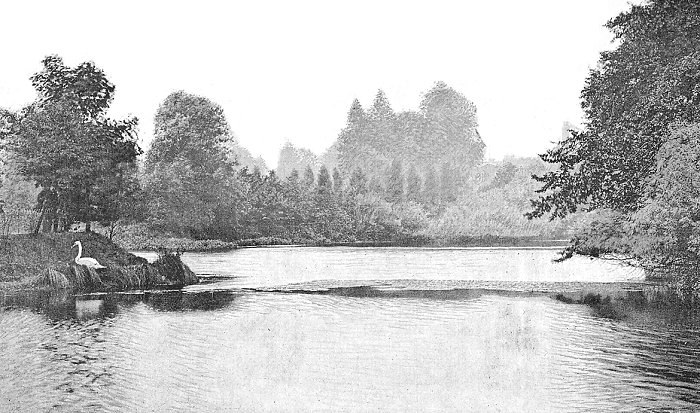
Hatherton Lake in the 1880s. |
|
Mining began in about 1800 to exploit
the vast amount of Lower Wenlock Limestone deposited there.
The workings became the largest open limestone quarry in the
town, which remained in use for around 35 years. There are
no traces or records of lime kilns in the area, so the
limestone was probably used in the local ironworks.
In 1835 John Walhouse died, and the
estate was left to his nephew Edward, who later became the
first Lord Hatherton. By this time most of the limestone had
been removed, and the workings were becoming uneconomical to
run. Mining ended, and the steam pumps were turned off, so
the workings soon flooded, and the lakes quickly formed.
Around this time the lakes began to be used for fishing,
boating, and ice skating in the winter. On Saturday 12th
July, 1845 tragedy struck when the Mayor of Walsall, John
Hyatt Harvey drowned in Hatherton Lake whilst taking an
evening swim. He often bathed there in the evening because
although it was a dangerous place, it was near the road and
in sight of several houses. Some people bathed there because
it was believed that the lime rich water had some kind of
medicinal value.
Sadly a second man drowned after
falling from his boat whilst searching for the body. Diving
apparatus was brought from London to help in the search, but
the bodies were not found. On the following day one of the
bodies floated to the surface. Although Hatherton Lake is
still up to 40 feet deep in places, it was much deeper when
the accident occurred. For many years afterwards the area
remained wild and untouched.
A Public Park
The Arboretum was founded in 1870 by
the Walsall Arboretum and Lake Company, in order to turn an
area of flooded limestone pits into an arboretum, public,
and pleasure grounds. The company had a starting capital of
£4,000, and in March 1873 took a 99 year lease from the
landowner Lord Hatherton for the lakes above the flooded
mine workings, and seven acres of adjacent land. The area
was to be developed into an arboretum and gardens, with
facilities for amusements such as boating, fishing, archery,
and croquet etc. There would be a lodge, a boat house, a
bandstand, toilets, and an ornamental garden through which
visitors could walk.
|
|
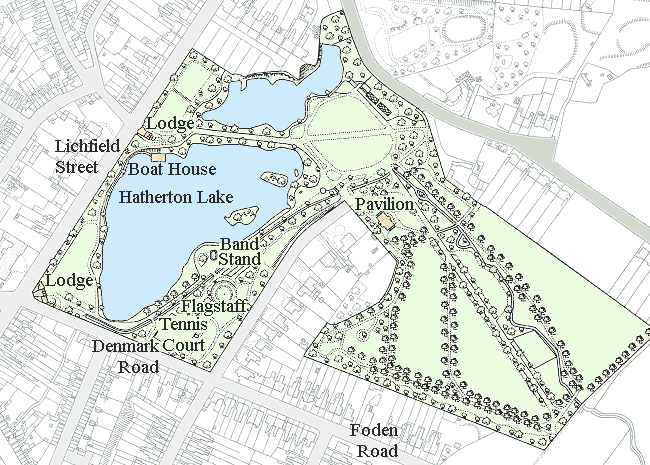
The arboretum in 1914. |
|
The grand opening ceremony took place
on 4th May 1874, when the park was officially opened by Lady
Hatherton in front of 4,000 people. The original park
consisted of two lakes, a boathouse, a bandstand, two
lodges, and several summerhouses. There was a tree-lined
promenade, space for dancing, croquet lawns, and a cricket
ground.
Despite an admission charge being made
in the first year, the company made a loss. The company then
attempted to improve its financial position by organising a
series of events in the Arboretum including fêtes, brass
bands, illumination by candles, balloon ascents, and
firework displays.
Visitor numbers soon began to fall due
to a lack of sporting facilities, and activities for
children. There were no refreshments, and many of the plants
had died because of poor planting. In an attempt to boost
visitor numbers, a cycle track was built in 1876.
Unfortunately the venture was not a commercial success, and
the company went into liquidation in 1877. Although Lord
Hatherton and a group of local businessmen took over, after
the company’s demise, the venture was still unsuccessful. In
1878 a steam boat called "Lady of the Lake" began to sail on
the lake, and in 1880 the first park keeper Thomas Everton
was appointed. He lived in the main lodge. In October of
that year, heavy rain badly damaged the cycle track.
|
|

The lodge, entrance, and clock
tower. |
|
In 1881, due to public demand, the
Council agreed to take the Arboretum over as a public park
on a three year lease, and in 1884 purchased the freehold
for £4,000. It officially reopened on 21st July, 1884. In
the following year, because of safety concerns, the Council
banned fishing, bathing, boating, and skating from the
lakes, which were badly affected by flooding in May 1886.
The heavy rain also caused the "Lady of the Lake" to sink.
In August a drinking fountain was installed, and in September the clock was installed in the
tower. By this time the Arboretum was becoming
very popular. On Whit Monday 1888 there were 10,000
visitors.
In 1889 improvements were made to the
flower beds, the lodges, the greenhouse, and the cycle path.
In 1890 the council acquired another 13 acres from Lord Hatherton to extend the park, which were opened to the
public in 1892. Boating was reinstated on Hatherton Lake,
and a brick bridge was built over Hoar Brook to replace the
old timber structure. An outdoor gymnasium for young people
also opened, and in 1899 a new bandstand was built.
The Early Twentieth Century
Further improvements soon took place.
In May 1902 the pavilion opened, and in 1904 the old stocks
were moved from High Street to the lake area. In 1905
waterfowl and swans were obtained for the lakes, and in 1908
new turf was laid, and part of the course of Hoar Brook was
concreted. Two years later another tennis court was added,
and in 1912 an outdoor swimming pool opened beside the
brook.
|
|
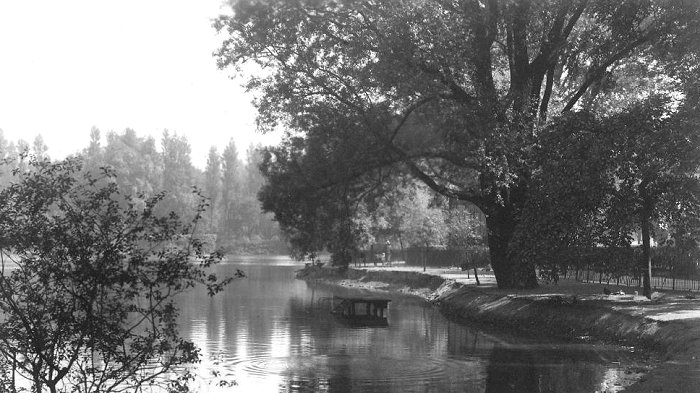
Hatherton Lake. |
|
The new Head Gardner, Mr. Wall,
appointed in 1915, oversaw a lot of new projects including
the cutting back and removal of some trees, the planting of
new flower beds, and the creation of a space for the Walsall
Floral and Horticultural Society Show.
During the First World War, dances were
held near the bandstand, and the Women’s Volunteer Reserve
helped with park maintenance, and the growing of vegetables
and potatoes, which along with timber, were supplied to the
Walsall War Agricultural Committee. Some of the waterfowl
were sold to raise money, and competent swimmers were again
allowed in the lake. Changing facilities consisted of
dressing tents which were erected beside the lake. In 1919 a
victory show and gala was held in the Arboretum to celebrate
the end of the war.
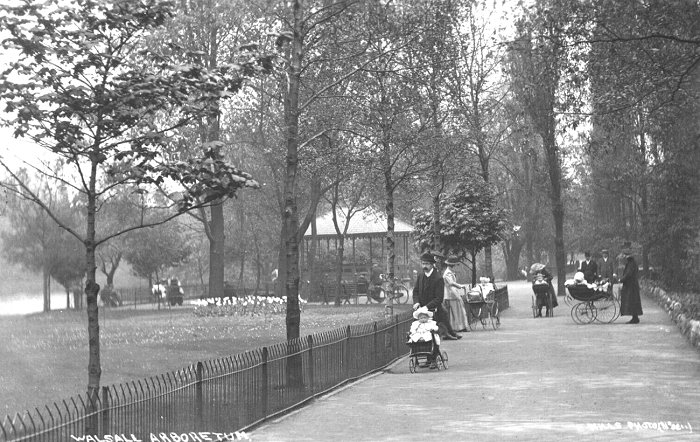
The Inter-War Years
In 1922 the park was extended by 20
acres, mainly thanks to the generosity of Mr. Featherstone-Dilke
who gave much of the land on the understanding that the new
development would provide work for the unemployed. In the
following year the Prince of Wales visited the park to pay
tribute to the ex-servicemen.
|
|
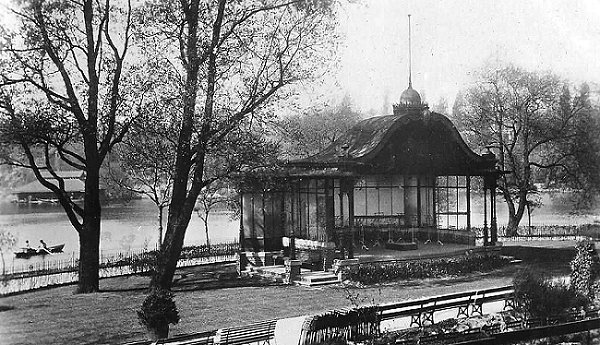
The bandstand. |
|
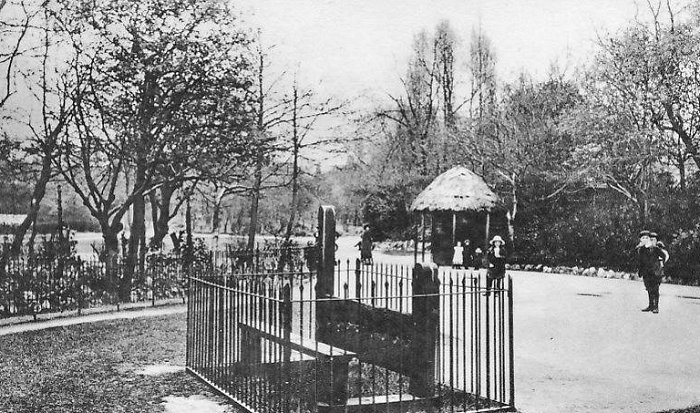
The old stocks. From an old
postcard. |
|
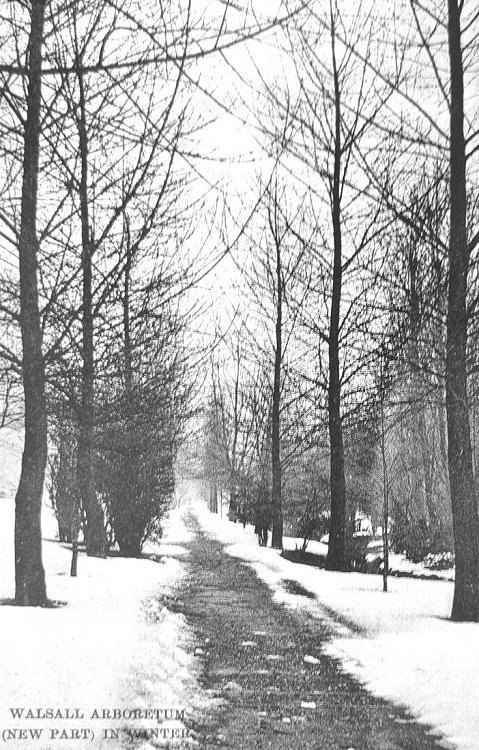
From an old postcard. |
1924 was another landmark year for the
Arboretum. In April a new bandstand, built by Walter
Macfarlane & Company, at a cost of £1,550 opened, and two
tubular swings, two giant strides and a merry-go-round were
acquired from Johnson Brothers.
Other new features included
a second children’s playground, a putting green, more tennis
courts, new footpaths, and new rock gardens. Finally another five acres were added to
the park for informal recreation and additional playing
fields. It had been purchased from Mr. Mellish’s trustees.
A new Park Superintendent’s lodge
opened behind the pavilion in 1925, and the ‘glacial
erratic’ boulder known as ‘The Devil’s Toe’ was placed near
the bandstand. In 1930 the park was extended again when Mr.
Featherstone-Dilke gave 20 acres of Calderfields Farm to the
Arboretum. Because jobs were found for the unemployed, who
carried out most of the landscaping, the Ministry of Health
provided a loan of £8,000. Work on the new extension was
completed in 1932.
Two years later the open air swimming
pool received a new filtration plant. Unemployed people were
allowed to swim there free of charge. In the same year the
Richard B. Sutton Shelter was built. |
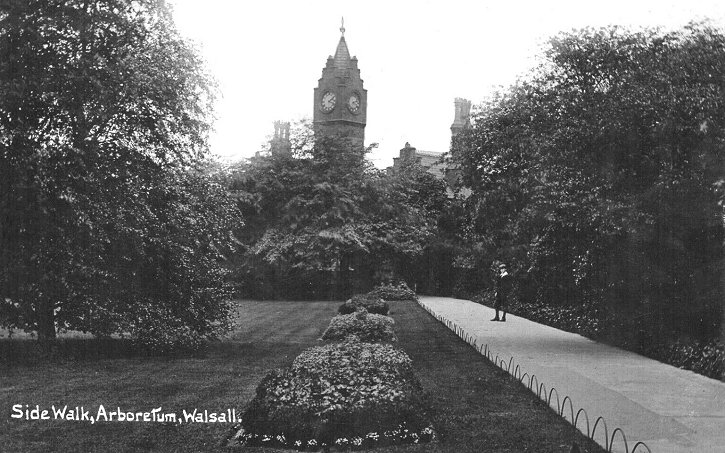 From an old postcard,
dated 1908.
From an old postcard,
dated 1908.
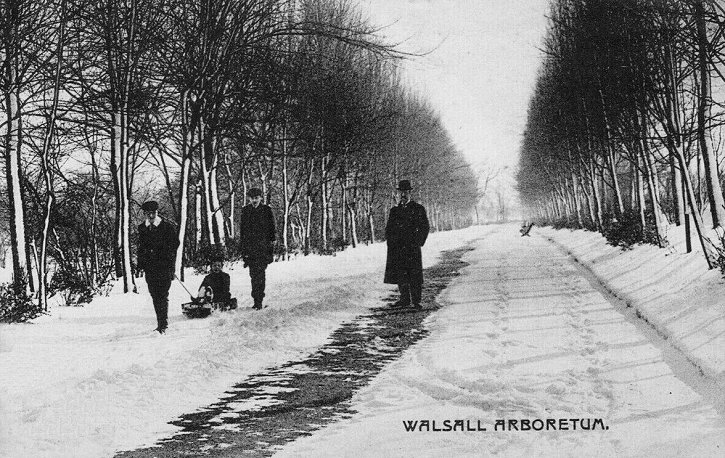
From an old postcard dated
1906.

From an old postcard.
|

The Pavilion. |
|

The pavilion. From an old
postcard. |
|
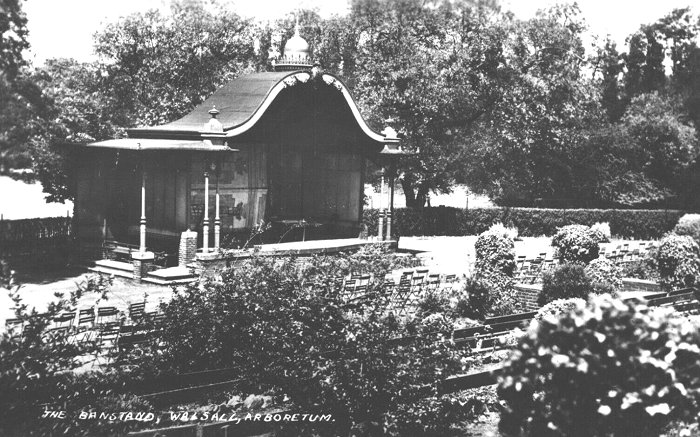
From an old postcard. |
|
In 1935 a further 50 acres were bought
from Mr. Fred Smith to extend the Arboretum eastwards along
the river valley, and celebrations were held for the Jubilee
of King George V and Queen Mary. In the following year the
pavilion was renovated, and became the Joseph Leckie Sons of
Rest for retired men. Cricket and Football pitches were laid
out on the Grange Farm extension in 1937, and work began on
the George V Avenue.
The Second World War and Beyond
During the Second World War, over 100
allotment plots were provided in the extension, and the
water level in Hatherton Lake was raised in preparation for
fire fighting, which would be necessary after bombing raids.
An important event, which would have a
great impact on the Arboretum occurred in 1951 when the
first Walsall illuminations were held to celebrate the
Festival of Britain. The popular annual event would continue
to attract large numbers of visitors for nearly sixty years.
|
|

Walking in the park. |
|
In 1952 the Council purchased 15 acres
of land to link the Grange Farm Extension to the Rushall
Canal, and in 1953, to celebrate the Coronation, the
Coronation Rock Gardens were added, the children’s play area
was replaced with a lido, more tennis courts were added,
along with a miniature golf course.
| From a newspaper cutting dated
4th August, 1953.
Day to be Remembered at Walsall.
Opening of Children’s Lido
Records for
attendance, gate receipts and
entrants in all sections marked the
opening of Walsall's two day annual
horticultural show and fete in
Walsall Arboretum extension
yesterday. Probably the most welcome
of all the records, however, was the
weather, for this was the first
occasion in 13 years that rain did
not mar the event.
The number of
people paying for admission was
30,780, compared with the previous
record figure of 28,000 in 1948, and
gate receipts were £2,489, against
the previous highest of £1,850.
It was all the
more appropriate that the weather
should have been so kind on this day
for it saw the opening of the first
instalment of the children's lido,
towards which the funds of the event
have been devoted in post war years.
If there was
ever any question as to whether the
lido was needed or not it was
answered within seconds of Belita,
the ice skating artist, officially
opening the two children's paddling
pools. Hardly had the tapes been cut
than hundreds of children rushed for
the pools and stayed there uutil
near closing time. |
|
In 1956 the open air swimming pool
closed and was filled-in. The changing rooms were converted
into an aviary, and a small café and tea garden was built on
a new concrete terrace. Two years later a garden for the
blind opened on a former bowling green.
Due to the long cold winter of 1963 the
lake froze over, and ice skating was allowed on the lake for
the first time since 1941. It was so popular that floodlit
evening sessions took place. In 1970 an artificial ski slope
was built, and in 1974 the Arboretum’s centenary was
celebrated with ten days of festivities. |
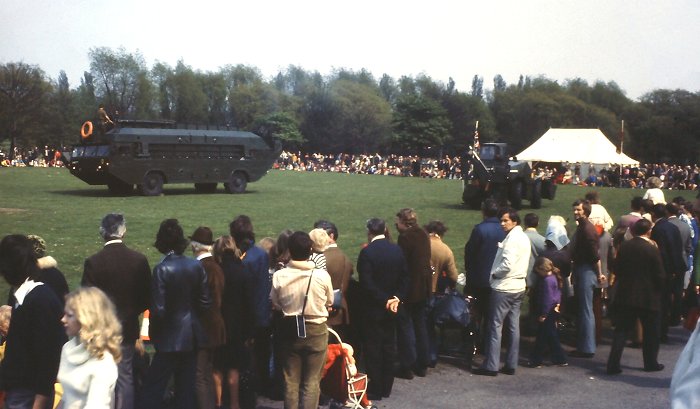
In about 1974 the army put on a
large display at the Arboretum, which attracted a lot of
visitors. Photo taken by Richard Ashmore. |
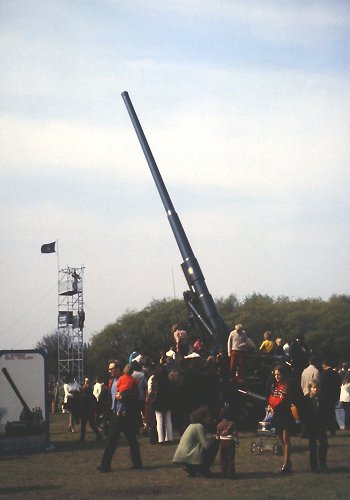 |
|
 |
|
The army
display included a high wire, a large gun, and
parachute jumps. Photos taken by Richard Ashmore. |
|
|
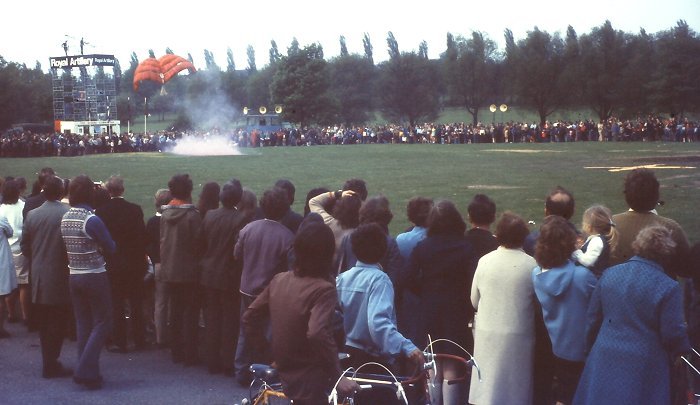
A large crowd watches the
spectacular ski-diving display. Photo taken by Richard Ashmore. |
|

Another of the parachute jumps.
Photo taken by Richard Ashmore. |
|
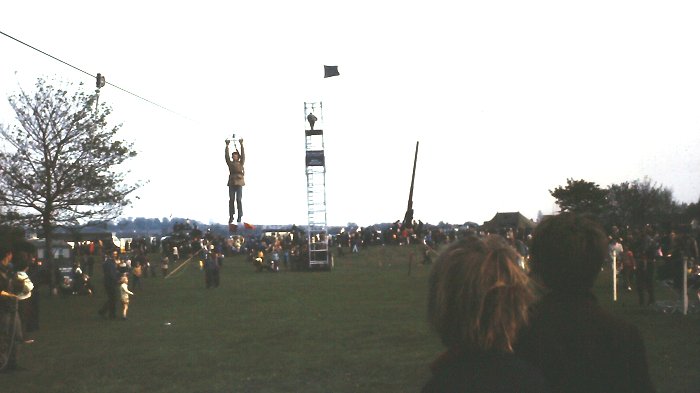
Travelling at speed on the high
wire. Photo taken by Richard Ashmore. |
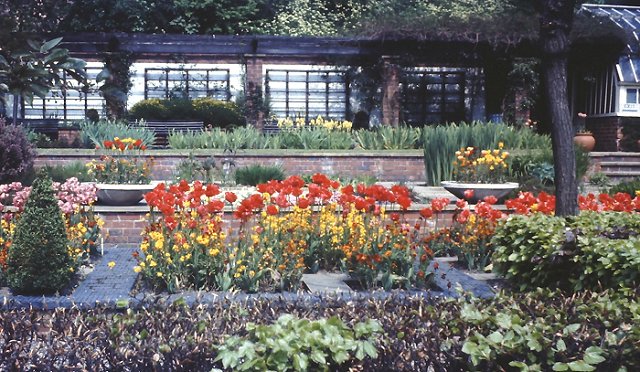
Some of the lovely flower displays
near the greenhouse. Photo taken by Richard Ashmore in
the mid 1970s. |
|
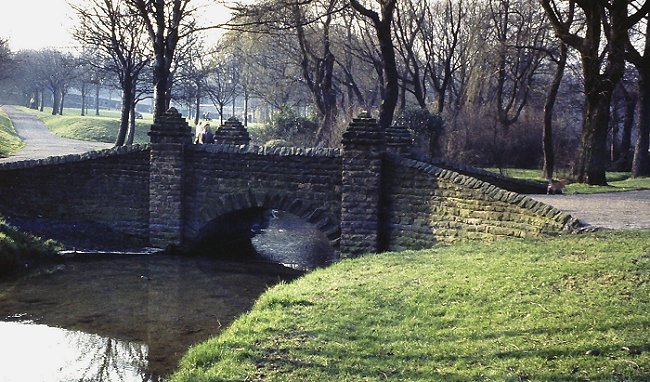
The Hoar Brook and one of the
bridges. Taken in the 1970s by Richard Ashmore. |
|
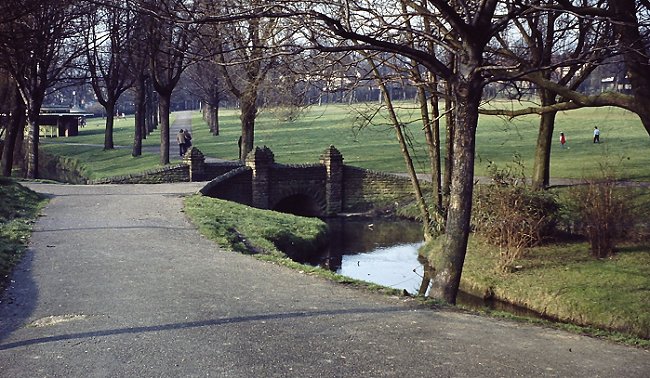
Another view of the bridge, also
taken in the 1970s by Richard Ashmore. |
| During 1975 ‘Paris in the Park’ art exhibitions were
introduced around the lake, and in the following year
the miniature railway opened. Trains started running on the 7¼ inch
gauge line at Easter 1976. Passengers were carried on 'sit
astride' coaches along the quarter of a mile or so of single
track. Initially it only operated on Saturday and Sunday
afternoons. There were at least thirteen engines including
the following live steam locomotives: an LMS Princess
Elizabeth, an LMS Duchess (Duchess of Buccleuch), three LMS
Black Fives, an LNWR 2-4-0 (Sister Dora), two BR 9Fs, an
LNER pacific, and four battery electric locomotives. The
line continued in operation until the late 1990s. By
1999 it was overgrown and derelict. |
|
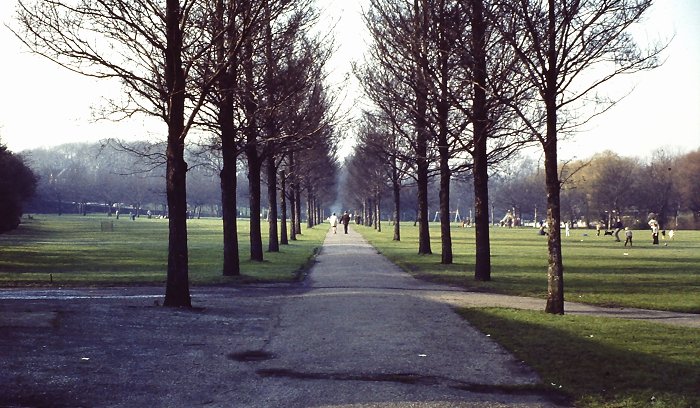
Going for a stroll in the park in
the 1970s. Taken by Richard Ashmore. |
|
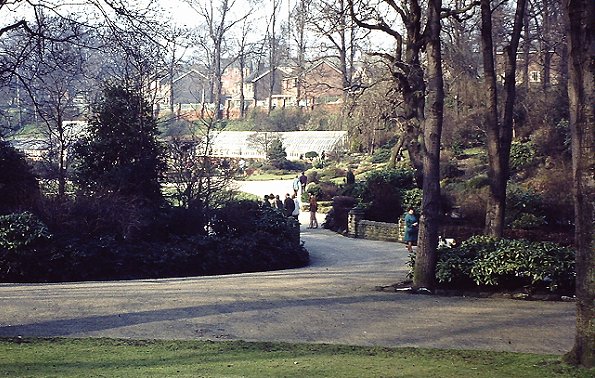
Looking over Hoar Brook to the
greenhouse. Taken in the 1970s by Richard Ashmore. |
|
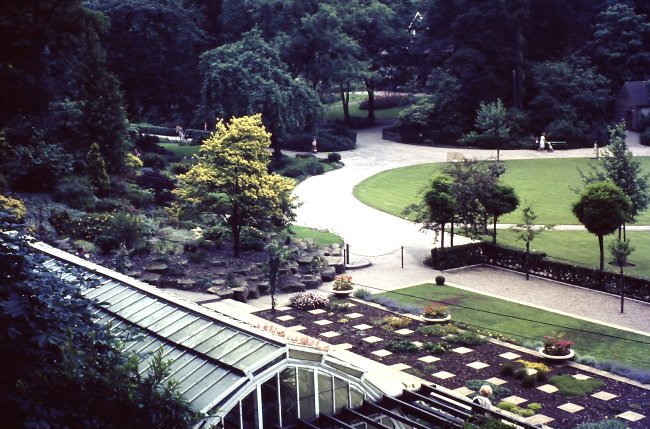
The greenhouse and flower beds.
Taken in the 1970s by Richard Ashmore. |
|
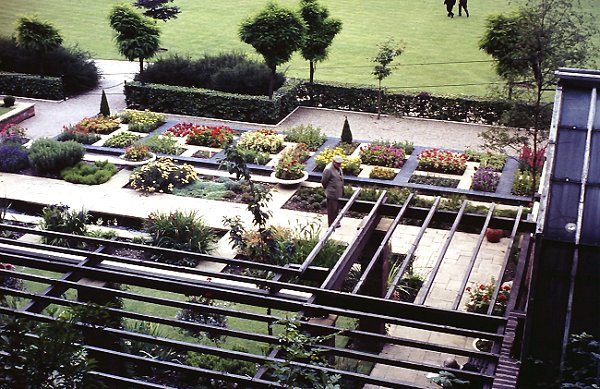
A closer look at the flower beds.
Taken in the 1970s by Richard Ashmore. |
|

Looking from the flower beds to
Hatherton Lake. Taken in the 1970s by Richard Ashmore. |
|
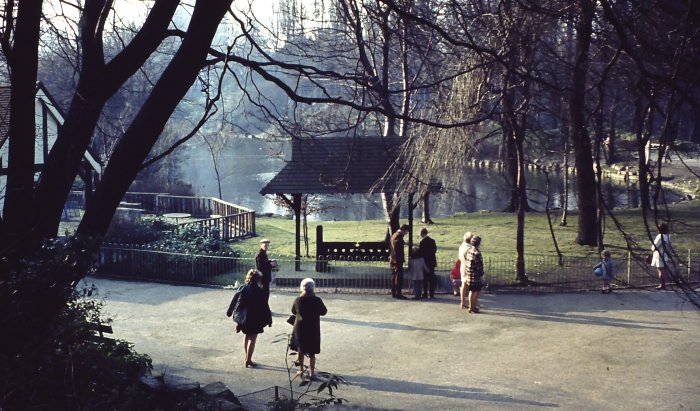
The old stocks that were removed
from High Street in 1904. Taken in the 1970s by Richard Ashmore. |
|
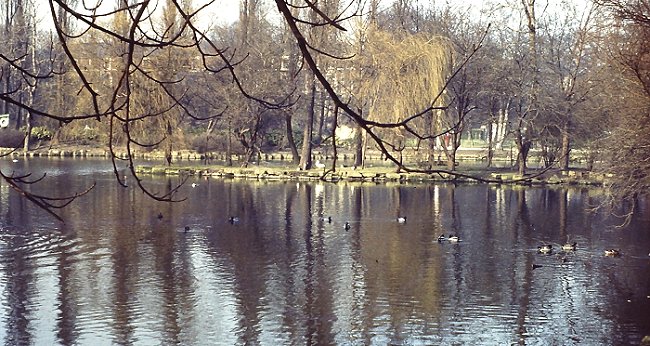
Hatherton Lake in the mid 1970s.
Taken by Richard Ashmore. |
|
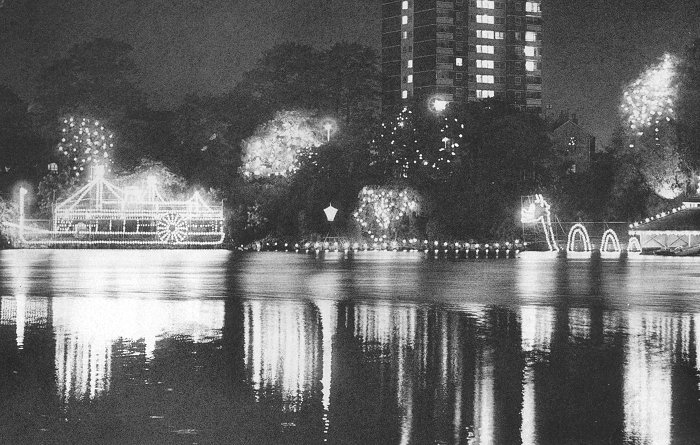
The illuminations in 1967. |
|
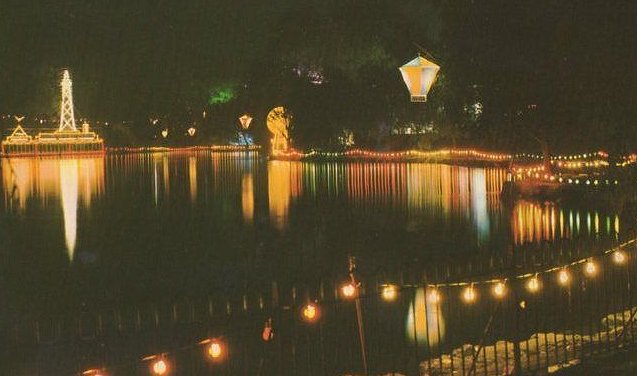
The Illuminations. From an old
postcard. |
|
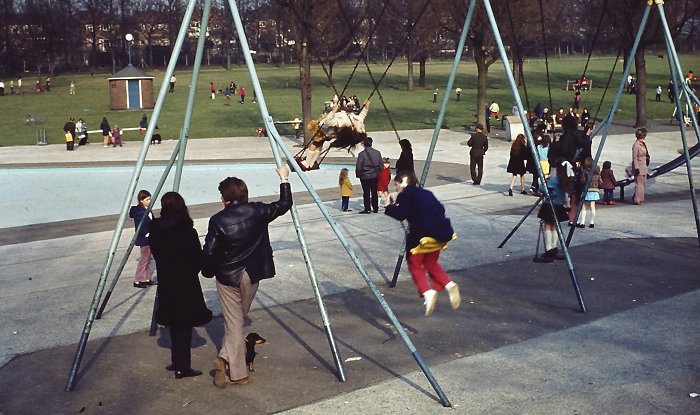
Part of the children's play area
and lido in the 1970s. Taken by Richard Ashmore. |
|
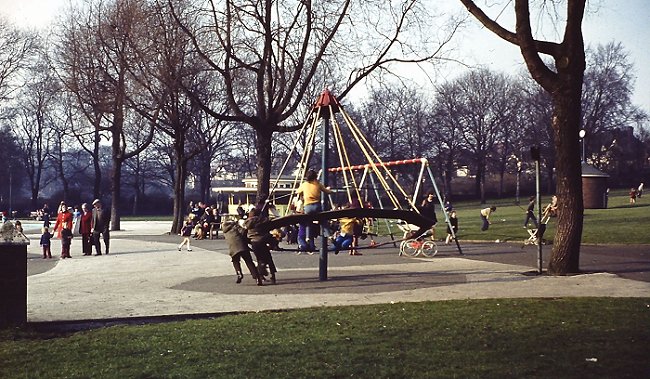
Another view of the play area from
the 1970s. Taken by Richard Ashmore. |
|
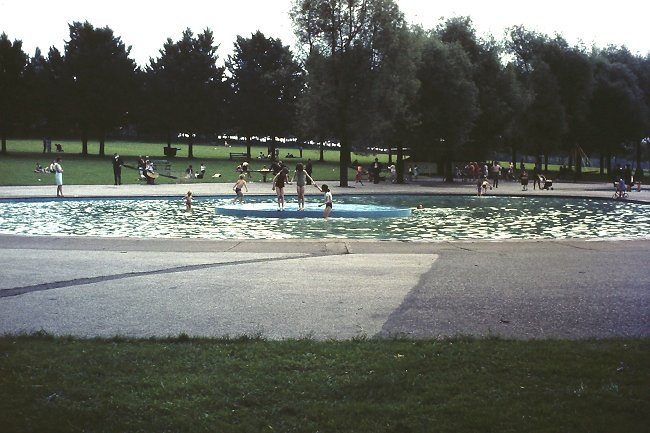
The paddling pool. Taken in the
1970s by Richard Ashmore. |
|
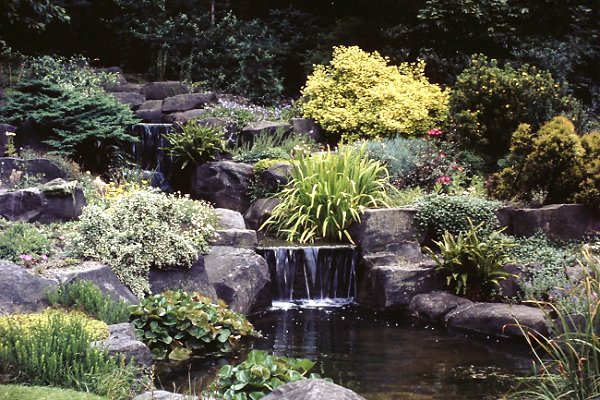
The Hoar Brook. Taken in the 1970s by Richard Ashmore. |
|
In 1984 the original part of the
Arboretum and the surrounding houses were designated as a
Conservation Area, and in 1987 the Grange Extension became a
privately managed golf course. In 1992 the aviary was
removed and replaced by a wooden gazebo, which provided
visitor information. Two years later the lido became a
combined playground and paddling pool called ‘Treasure
Island’.
In 1995 a Charter Mark was awarded to
the Arboretum for the excellence and diversity of the
services it provided. It was awarded again in 1999 when the
125th anniversary celebrations included a big summer party.
In the same year, new walking trails opened and a rare
species of white-clawed crayfish was discovered in Hatherton
Lake.
In February 2009 Walsall Illuminations
temporarily closed for three years due to financial
constraints. In March 2011 it was announced that the
illuminations would be scrapped.
|
|
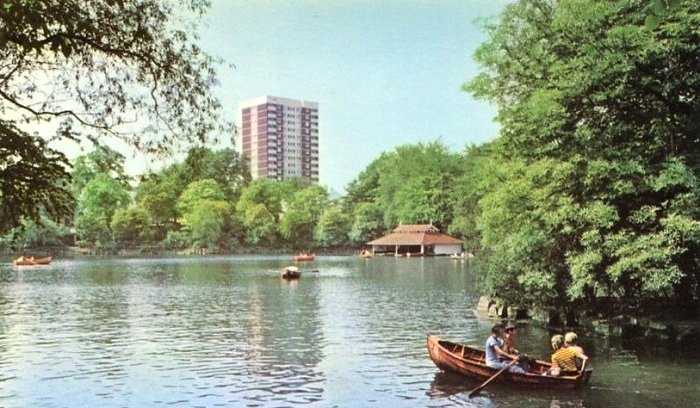
Boating on Hatherton Lake. From an
old postcard. |
|
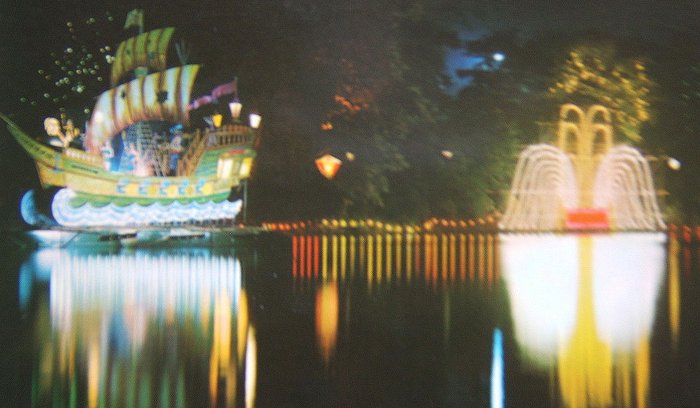
The Illuminations. From an old
postcard. |
|
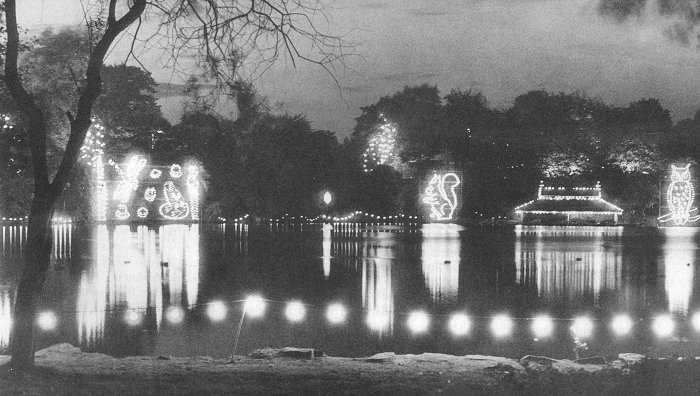
The illuminations in 1973. |
|
There are now many and varied
activities in the park for children. The new £180,000 skate
park built in September 2010 provides excellent facilities
for children of a mixed range of ages and abilities, and is
suitable for BMX’ers and skaters. The new facilities include
a multi-use games area, a shelter, and a graffiti wall.
The old lido has been revamped and
brought up-to-date by the building of a 440 square metre
slashpad with an amazing array of 28 water play features
suitable for children of all ages. There is a splash pool
for the smaller children and interactive water jets for the
older children.
Other work has included an impressive
decked viewing area over the lake, a refurbished bandstand,
refurbished tennis courts, refurbishment of the Grade II
listed boathouse, resurfaced footpaths, new bins and
benches, repainting of the Sons of Rest building, a neat and
tidy rose garden, and a lot of planting work.
|
|
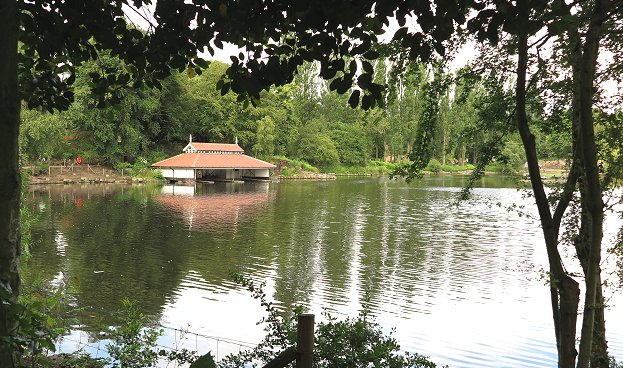
The restored boathouse in 2014.
|
|
The showpiece of the multi-million
pound revamp of the Arboretum is the new visitor centre
which includes a café, a classroom, changing rooms, a
meeting space, toilets, and offices. The contractors,
Willmott Dixon Limited have also installed lighting along
the pathways near the lakes. The £7.9m revamp of the
Arboretum has been made possible thanks largely to the
Heritage Lottery Fund.
On March 28th, 2015 boating returned to
Hatherton Lake after an absence of almost twenty years. The
swan-shaped pedaloes will operate over part of Hatherton
Lake, leaving an undisturbed area for wildfowl. The boats
are operated by Dunton Stables from Sutton Coldfield.
The Arboretum today
The Arboretum is still a popular
destination for people from Walsall and the surrounding
areas. Every year millions of visitors greatly enjoy the
facilities, and the lovely parkland. Concerts are held in
the bandstand, and a wide variety of events are held in the
park. Over the years it has been a great success, and has a
wonderful reputation, second to none. It is greatly
appreciated by much of the local population, and hopefully
will continue to provide the excellent facilities for years
to come.
|
|
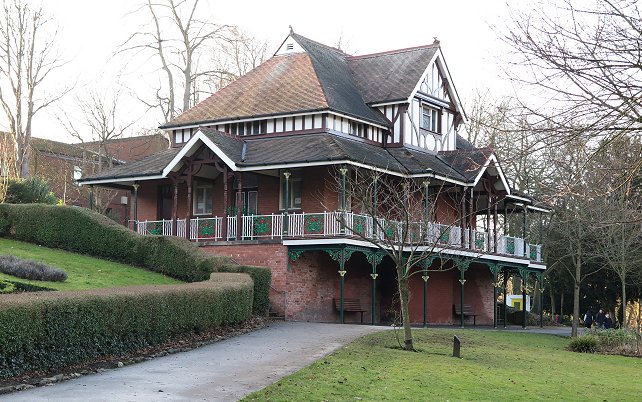
The Pavilion in 2015. |
|
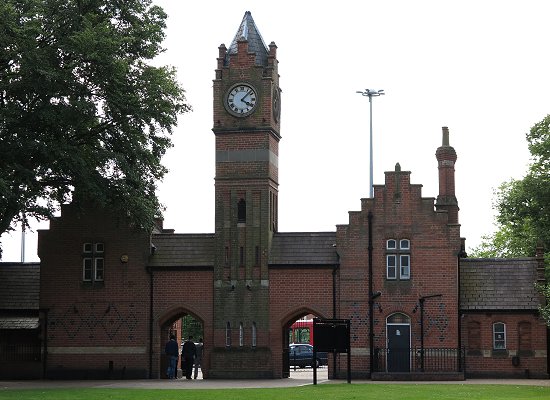
The entrance lodge and clock tower in 2014. |
|
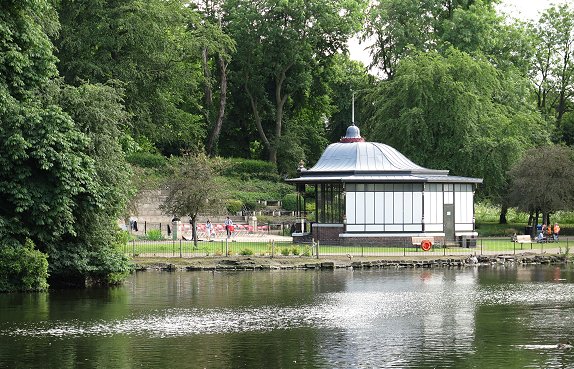
The splendid bandstand that was restored in 2011. |
|
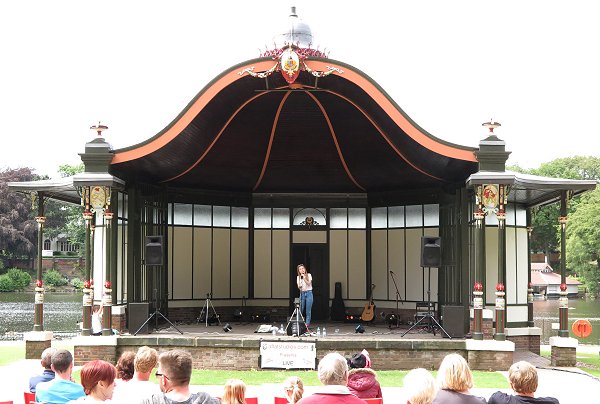
A concert at the bandstand on 29th
June, 2014 featuring Sophie-Rose. |
|
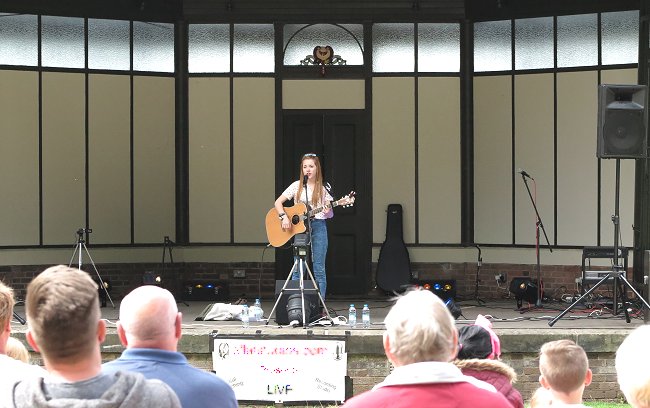
Another view of Sophie-Rose in the bandstand. |
|
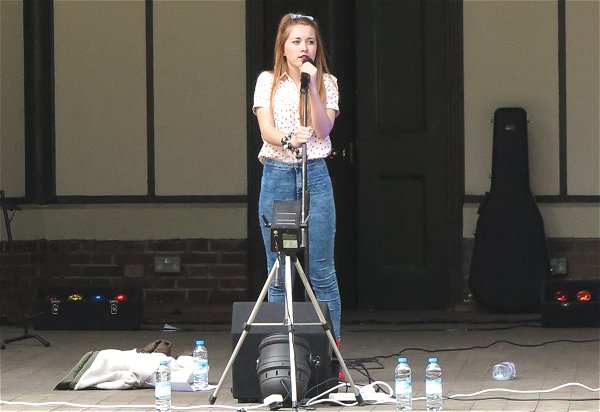
A final view of Sophie-Rose in
concert at the Arboretum. |
|

The swan-shaped pedaloes on Hatherton
Lake. |
|
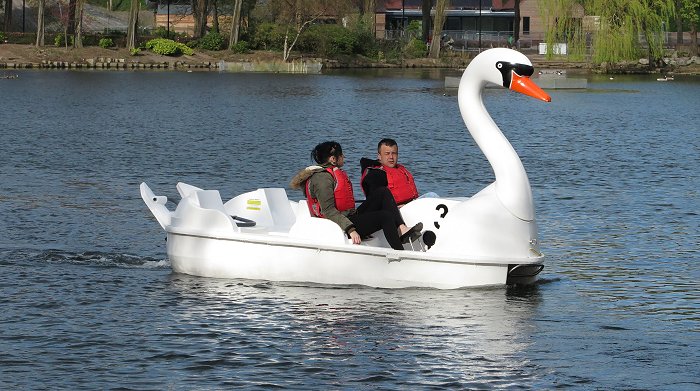
A close-up view of a swan-shaped pedaloe
on Hatherton Lake. |
|
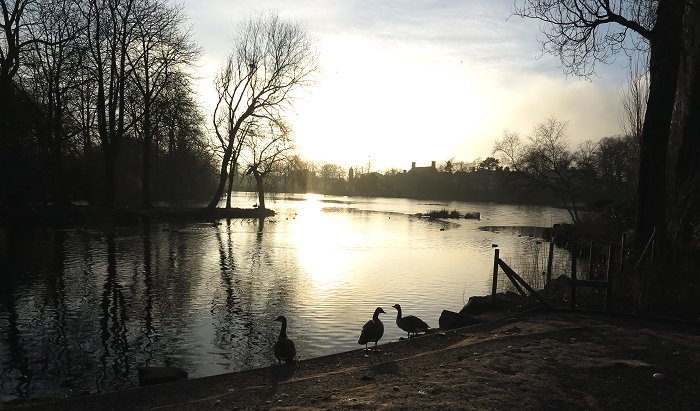
A winter's sunset over Hatherton
Lake. |
 |
Return to
the
previous page |
|

